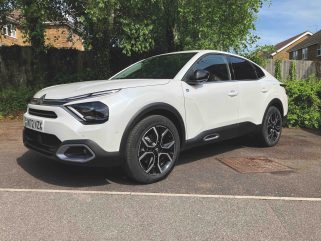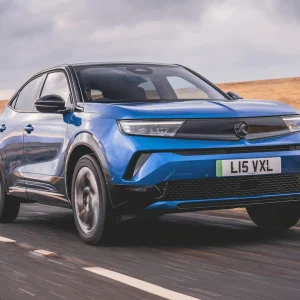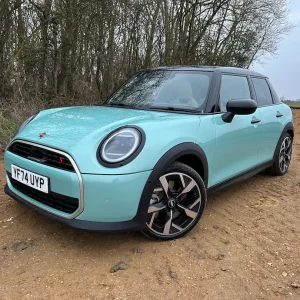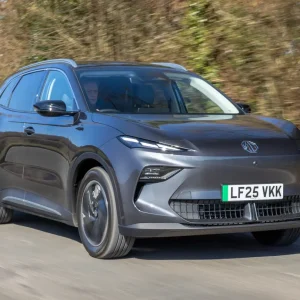
Final Report: ‘Yes’ more than ‘No’
After half a year with the unusual all-electric E-C4 X – five months with yours truly and one with colleague Sean Keywood – what did we make of it? Sean was up first and for starters wasn’t sure about Citroen’s ‘fastback’ categorisation, preferring “high-riding saloon” on account of its SUV height and boot hinge below the rear windscreen. To be fair, fastbacks don’t have to have a roof-hinged hatchback to qualify, but the term generally does denote a car with a roof that slopes rearward with little or no interruption. The E-C4 X by contrast, has a stubby and near-horizontal boot lid, which to my mind makes it more of a ‘SUV notchback’ or ‘crossover
with a boot’.
Body-style semantics aside, Sean also liked the car’s front-wheel drive 136hp electric motor, describing it as “more than sufficient” and also the car’s clear reversing camera screen and intuitive steering wheel-mounted cruise control toggle switch and button. I agree and found the car pretty easy to live with. For me, the E-C4 X’s distinctive exterior silhouette, smart interior feel and on-brand, comfort-biased suspension system are its best attributes, but I have some caveats, ranging from mild, to quite annoying.
While the X’s 510-litre boot is big – and 130 litres bigger than the regular E-C4’s 380 litres – it’s sometimes hard to access, due to a fixed parcel shelf and relatively small aperture. With seats folded, large-frame bicycles can’t just be slung in the back. One will fit in, but major head-scratching and significant wrestling make the process hardly worth the bother. Other odd features include a driver’s seat with electric vertical, but manual horizontal adjustment, hill-hold assist that only works sometimes and an On/Off button that requires a considerably long press to activate – and then lacks clear visual or audio confirmation – so that even regular users inevitably and routinely press it again, only to find they’ve turned the car back ‘On’ or ‘Off’, when they really wanted the opposite.
The infotainment system on the E-C4 X is ‘previous-generation’ by Citroen’s own standards and way off the leading players’ offerings. Although it can work wired or wirelessly with Apple Carplay, it was annoying to repeatedly have to select the phone from the car’s screen upon start-up. It rarely remembered, or if it did, not very quickly. Then Citroën’s phone app went through weeks of not updating at all. This was really annoying when I simply wanted a remote update on the car’s overnight range after plugging in at a public charger a few streets away. The issue was finally resolved via the removal of some privacy settings on one of the phones linked to the car that had been blocking communication with my phone and the car, but the solution took time and lacked intuitiveness. ‘Over the Air’ updates did work, but didn’t update the sat nav sufficiently to stop suggesting routes that would have incurred me a fine or were blocked off, so Apple CarPlay and its maps – while not perfect – became my default.
I did try the car’s Sport mode, but it didn’t bring a great deal of extra enjoyment. Most of the time I stuck with Eco and the extra brake-regen B button pressed, in my attempt to get closer to the car’s official-combined 221-mile range. While that range was never achieved – 180 was more usual in my real world – it proved enough for 95% of the time. I only elected to swap into a longer-range petrol vehicle once, when needing to drop my youngest daughter to university in Manchester from London on a deadline. Despite testing the E-C4 X in the warmer summer and autumn months, 4.0 miles per kWh remained its decent, but stubborn average (with a 3.4m/kWh low and 4.6m/kWh high either side). However, as the E-C4 X returns, we’ll miss its unusual shape, style and French-ness and also marvel at its keen price: with a £34,440 P11D price and £36,115 as tested, it’s a lot of EV for the money.
5th Report: “Calling IT…”
Once upon a time carmakers concentrated on creating desirable-looking cars with solid combustion engines – and hopefully great handling – which incrementally increased efficiency and power at every model update. Then came along the pesky smartphone – as trailblazed by the Apple iPhone in 2007 and many others after that – and the whole world changed.
Too strong was the allure of having a portable screen and mini computer through which users could access all the world’s online information, as well as endlessly communicate with friends and family while sharing the latest skateboarding cat video or the view of a beautiful sunset from a holiday somebody else was enjoying. Now in 2023, despite whatever other primary activity should take precedence, (almost) everyone looks down at their smartphone more than what they should be doing or where they are going.
.Which is a dangerous enough state of affairs in rush-hour walking along a London pavement but of course way worse at 70mph – or even 20mph – on the M25. Carmakers were late to suss out this trend and have been playing catch-up ever since. Back in the early part of this century I remember talking to a very senior car designer about the issue and he quipped something along the lines of, “the trouble is, Apple has 100s of designers working on their one screen, where we have two”. His brand’s then very small, non-colour, hard-to-use screen – then known as a ‘Human Machine Interface’ or HMI – wasn’t much of one. And since then, despite an industry re-brand of the technology to User Interface (UI) or the even grander User Experience (UX), most carmakers’ infotainment screens (and associated apps as well) are still terrible.
The radio station menu within E-C4 X’s infotainment screen is a good example. It was once there, but has now gone missing and I have searched in vain to find it more than once since. The car’s in-house sat-nav mapping is simply not current enough either – despite having had an ‘over the air’ update within our tenure with this test car. So much so, on the odd occasion I have used it, the nav suggests trying to drive down roads long-closed to private cars and which might garner a fine in the process. Which is stressful. So Apple Carplay and its maps are my default – knowing that my phone-related software will not only be aware of the latest closures or diversions in place, but will also know the quickest route at the time of day I’m driving too.
On one night recently though, a funny thing happened. Despite having Carplay mapping and menu in place across the main E-C4 X screen, a little voice piped up – that wasn’t Apple’s ‘Siri’ or its usual sat-nav guide – saying quietly, intermittently but repeatedly, “I didn’t get that.” Eventually we found a way to turn it off, but it seemed a particularly apt phrase for the state of not only Citroen’s user experience, but also almost all (traditional) carmakers. Is it time to give up the chase? Or at least strip down their infotainment offerings to the bare minimum and then concentrate on making the connection with the third-party software providers as smooth and easy as possible and let Apple, Microsoft or whichever other third-party which can so obviously do it better, do it better? The money saved could then be spent elsewhere on what 21st century carmakers are actually really great at, like, ride, handling, comfort, quality and fit and finish. you know, the ‘making cars’ bit.
4th Report: Who’s taken my tablets?
Poking about in a parked-up new car is one of the undoubted roles of any self-respecting test driver. But it can garner strange looks, some of which go beyond those of bemused neighbours, to those on the testers’ faces themselves, especially when they strike upon something they haven’t seen before. So it was for me within the Citroen e-C4 X, when I spied a few mysterious extra drawers on its passenger side dashboard, just above the traditional glove box.
To be fair, I had stumbled upon them early on in my time with the test car, when I saw what looked like a chunky iPad case or similar in one slim horizontally-opening drawer and some kind of related fold-out stand from the drawer above. Resolving to investigate another time, that time finally came about the other day.
After some wrestling and wrangling, and turning things round a few times I finally managed to fit what turns out to be just a case for a smart tablet like an Apple iPad – or indeed a Samsung Galaxy – not the actual device itself. Feeling a bit like Eeyore the donkey in the Winnie-the-Pooh story where he gets ‘the birthday gift’ of an empty honey pot from the eponymous round bear (because Winnie had been peckish and eaten all of its contents just before delivering the present) I was nonetheless still quite pleased I’d managed to make it all work. I even took a photograph of the case proudly in situ mounted on the dashboard front, if not with a tablet in situ inside of it.
Now I’m no luddite. I own an array of Apple products – from phones to laptops and even computers – but alas no iPad. So to bring you the virtual benefits of this undoubtedly well-designed bit of dashboard packaging I did some research and found that if you did own an iPad this set-up would then allow the passenger to enjoy playing with it while on the move without distracting the driver (as the latter can’t see the screen’s content when so stationed). And when your passenger is done with their iPad fun, the case slides upwards relatively easily from its temporary perch with the nudge of a few latches on its back and stows back inside its bespoke slim tray. Formidable!
Anyway, it turns out that the e-C4 X has more secret storage solutions to reveal than just this optional £100 Citroen Smart Pad Support case (the dashboard drawers are standard on Shine and Shine Plus trims). Another neat – and less prescriptive – storage area can be found ahead of the automatic gear selector toggle and on this car, to the left of the 12-volt socket. At first glance it looks merely like a zig-zag patterned flat mat for stowing phones, keys and more, but it turns out it is also a lid for a small cubbyhole beneath which can house keys, cash or similarly tempting small stuff out of view from potential thieves when parked. This is a good space and not obviously a cubbyhole, unlike the storage with the sliding lid just behind it.
On the subject of interesting details, we have to give Citroen’s designers and product planners credit for their egalitarian approach to phone charging options. The e-C4 X has a wireless tray above the aforementioned hidden mat/lid, but also two ports – one for USB and the other for USB-C type charging cables – which is a laudable move for a mainstream brand, rather than some other fancy car brands which have opted to be USB-C only. This egalitarian approach extends to the rear seats too, where the back of the central armrest also houses a USB and USB-C port, nestling just under the rear air vents. Charging equality without discrimination, beautiful.
3rd Report: Frenchness: Pros and cons
That there is something French about the Citroen E-C4 X is largely a good thing. Brands need identities and the nationality of any carmaker is often a beneficial factor, especially when that nation is perceived around the world in a mostly positive light. Carmakers associated with countries with despotic dictators and appalling human rights records tend to export less well.
Many of us like going on holiday to France because the food is great, the weather – especially down south – is usually better than here and there’s a style, flair and freedom to a lot of the things its citizens design and produce. And French people know how to enjoy themselves. There’s a phrase for it that even those who barely passed their French GSCE will probably know – joie de vivre – but if you don’t, Google Translate will quickly tell you it means the ‘joy of living’.
The E-C4 X has a joie de vivre about it. It’s found in its pleasingly swoopy exterior shape, not able to be pigeonholed as yet another crossover, or a crossover coupé or even just a saloon – although it does have four doors, five seats and a boot. This Frenchness is also found within its comfort-oriented interior, with well-padded part-leather heated and massaging seats with distinctive lozenge-shaped grey stitching. As part of the optional £800 ‘Hype Black interior ambience’ pack – which also includes a fancier steering wheel and carpet mats – I think it’s a worthwhile addition.
A specific Citroen layer to this Frenchness is in the E-C4 X’s pliant ride, in keeping with the brand’s long-held comfort-biased approach and created by its trademarked Advanced Comfort Suspension system, featuring double hydraulic stops front and rear. The resulting super-smooth gliding effect in motion is tangible to both driver and passengers alike and is a world away from the harsher thuds and crashes over bumps and speed-bumps that stiffer suspension set-ups associated with sportier (and mainly German) brands suffer.
But there are downsides to this idiosyncratic French approach to car-making, which manifest in different ways on the E-C4 X. Last month I mentioned my concern that its relatively small boot lid and aperture – rather than a hatchback-style tailgate and huge hole – might make swallowing certain bulkier items, like my large-frame road bike, trickier. To reduce stress levels when I wasn’t in a rush, I tried it. After some head-scratching and much metal wrestling, my slightly slimmer bike with the narrower handlebars did fit inside. But only by manhandling it through the rear doors first and then yanking the other end towards the boot’s edge back and forth until the twisted handlebars eventually ‘belly-danced’ under the fixed, low parcel shelf. In summary, it’s a real pain, which I wouldn’t attempt again, unless I really had to.
Another odd detail of the aforementioned and otherwise good Hype Black interior ambience’ pack is that it includes four-way electric driver’s seat adjustment but forward and aft movement still has to be done manually. To me, that’s weird. Or the grab handle on the driver’s side head rail which my head bangs into far too often, due to the angle of the ceiling. Or the touchscreen message on start-up that suggests my phone needs reconnecting but seconds later actually doesn’t. Or the Hill Start Assist, which seems to work sometimes but not others. Or even the E-C4 X’s On/Off button, which after my previous long-term test vehicle – the ‘just get in, select a gear and go’ Volvo XC40 Recharge – now seems superfluous. And is hidden by the steering wheel. Maybe some of these small annoyances would have been ironed out before going into production if Citroen’s engineers and designers hadn’t embraced that French joie de vivre approach to life as strongly. Who knows? But overall I still like the E-C4 X more than I don’t and I’m glad it exists. The car world needs more variety.
2nd Report: Citroen’s mysterious ‘crossover’
The trend for coupé crossovers or sloping-roof SUVs can be traced back to the trailblazing early 21st century 2003 Infiniti FX45. Remember that? It was a big thing: 4.8m long and some change. But it appeared smaller – and crucially looked more sporty and dynamic – courtesy of that raked rear roof section. It sold pretty well (especially in the US) and the body style went on to influence most (if not all?) German premium brands and their rivals to bring out similar models within their SUV line-ups.
Now Citroën is doing something similar, but full-electric, with the E-C4 X. After my colleague Sean Keywood’s introductory article I have the keys and in so doing, am swapping Swedish for French, geometric for swoopy and SUV for coupé crossover – or perhaps should that be high-riding saloon / notchback? It’s an interesting shape that’s hard to classify. Either way, my initial thought was that this would be a more stylish choice than the regular C4, but might mean facing a few hidden compromises, such as less headroom and boot space for starters.
But a little bit of dimensional research suggests that this is not the case. Unlike the Volvo C40 SUV coupé, which I reported on back in March versus the XC40 SUV – and found to be a little shorter (-9mm), narrower (-13mm) and unsurprisingly quite a bit lower (-70mm) – the E-C4 X is actually considerably bigger than its regular crossover ë-C4 sibling in key areas.
At 4600mm, the E-C4 X is a significant 240mm longer than the E-C4 and at 1834mm across, 34mm wider too. Remarkably the E-C4 X’s rear-sloping roof is the same height as the E-C4 (both 1525mm). Consequently, the E-C4 X feels spacious in the rear seats in a way that I hadn’t expected and its boot space – as Sean pointed out – is actually 130 litres more than in the E-C4 (380 vs. 580 minimum). Which is a decent amount for that size of car. That space also has an underfloor cavity big enough to chuck its charging cables into, without needing to memorise an intricate folding pattern in order to get the load floor lid to shut flush. In comparison to most (overly small) charging cable zip bags on PHEVs, this is progress.
Another surprise is the E-C4 X’s relatively small boot lid and aperture rather than a hatchback-style tailgate and huge hole. Hinged at the base of the rear windscreen, it’s neatly hidden in terms of rear exterior appearance, but I’m concerned it might make swallowing certain bulkier items – like my large frame road bike for instance – a bit trickier. Time will tell. I’m not totally sold on the overall very busy exterior design though. In particular, the extra crease line behind the front wheel arch which drops diagonally at the start of the front door seems to complicate the surfacing of the bodyside without adding much visual interest or coherence. But this stuff is somewhat subjective.
From the inside, I’m impressed with the general level of comfort in the seats – a now firmly re-established Citroën trait and brand value – and the care and attention the designers have taken in carving out places to put various driver and passenger paraphernalia, more on both of those details another time. Initial impressions of the ride are Citroën-smooth, especially in full-electric guise, but the rear view seems a little constrained by the high tonneau cover. So high in fact, I had to check it hadn’t somehow come loose, but of course as a car with a boot, it is fixed and more of a parcel shelf.
In the next few months, I’ll be putting the 136hp electric motor through its paces and seeing how the 50kWh battery holds its charge in relation to the 221-mile Combined range – and official, but surely very optimistic 304-mile City figure. The latter locale is where this car will spend most of its time and the summer is upon us, so at least warmer temperature is on the E-C4 X’s side.
1st Report: X factor
By Sean Keywood
One Citroen has replaced another on the Business Car fleet, and we’re upping the ante in terms of electrification, with the plug-in hybrid C5 Aircross that left last month making way for the pure electric E-C4 X.
Introduced as a spin-off from the E-C4, the E-C4 X is described by Citroen as a fastback, though it’s more like a high-riding saloon, with the boot lid hinged at the bottom of the rear window. That boot is however 130 litres larger than the regular E-C4’s, and the X’s more aerodynamic shape means it should manage a few extra miles between charges.
While the regular C4 is also available with petrol or diesel engines, the X is electric-only. Power comes from a 136hp motor, which might sound a little modest for a car this size. However, while there’s certainly not the tyre-shredding acceleration you get with some EVs, on early drives in the car it’s proved more than sufficient, and never felt underpowered. If you do want more shove, a 156hp version will soon be added. That model will also come with a 54kWh battery pack, in contrast with the 50kWh offered by our car, which equals an official 221-mile range. So far around 200 miles feels like a reasonable real-world estimate, which isn’t bad since to this point it’s mostly been used on motorways. The car has a 7.4kW onboard charger for AC charging, or power can be taken from DC rapid chargers at up to 100kW, which should allow a 0-80% charge in half an hour.
Our car is in the mid-range Shine equipment grade. Standard features that have been notable early on include the head-up display, which offers useful information and is a welcome way of keeping the driver’s eyes on the road – though the theatrical way it rises from the dashboard before every journey feels a bit over the top. Also, the car’s reversing camera offers a much clearer image than the one from our previous C5 Aircross.
Other advantages over the C5 I’ve noticed early doors include more intuitive cruise control buttons on the steering wheel, and speed camera warning noises that were a) less piercingly loud, and b) easier to turn off.
Options fitted to our new car include Pearl White pearlescent paint, which looked pretty good when it was delivered. Unfortunately, my long-term test cars get parked under a tree and therefore accumulate dirt quickly, which with this finish is fairly conspicuous. Still, it does at least contrast nicely with the black and silver alloy wheels, black door mirrors, and black shark fin antenna.
Also fitted is the rather confusing Hype Black interior option which contains a real mish-mash of stuff that I won’t repeat from the list below – perhaps the most notable inclusion is the heated seats, which will obviously see a lot more use as we head into the winter months.
Overall, we’re off to a solid start with the E-C4 X – time will tell if it proves as trusty a companion as its C5 Aircross predecessor.
Standard equipment:
Automatic LED headlights, LED DRLs and front fog lights, electrically heated folding and adjustable door mirrors, automatic wipers, dark tinted rear windows, automatic dual-zone air conditioning, heated steering wheel, 5.5in backlit TFT driver display, head-up display, 10in infotainment touchscreen with sat-nav, wireless Apple Carplay and Android Auto connectivity, four USB sockets, 7.4kW onboard charger, remote temperature pre-conditioning, all-round parking sensors, reversing camera with top rear vision, autonomous emergency braking with night-time function and cyclist detection, speed limit information and extended traffic sign recognition, driver attention alert with lane departure detection, adaptive cruise control, blind spot detection, in-crash braking.
Options:
Pearlescent paint (£720), Hype Black interior with black leather and leather-effect seats, heated driver and front passenger seats, central folding rear armrest with cupholders and ski hatch, fitted carpets and mats, four-way electric driver’s seat with manual longitudinal adjustment, driver’s seat electric lumbar adjustment and massage function (£800), universal tablet cradle, dedicated Apple iPad Air 2 cradle or Samsung Galaxy Tablet A 10.5in cradle (£100)





